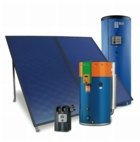Exploiting solar hot water for commercial applications

• the introduction of local legislation (Merton rule of 10% on renewables);
• the implementation of the Energy Performance of Buildings Directive;
• the take up on Carbon Trust grants on renewables. Additionally the forthcoming EU directives and implementation measures on the use of renewables supporting the European Energy Policy, to achieve a 20% reduction in carbon-dioxide emissions by 2020, a 20% improvement in energy efficiency and a 20% share of renewable energy. These objectives have stimulated the development of technology applied to solar, with new higher-efficiency collectors and controls to allow the greater exploitation of available solar energy in the UK. In dealing with the basics, there are two mainstream forms of collecting solar energy. Photovoltaic panels have been developed from the space programme and rely on ultra-violet light reacting with a silicone wafer captured in a ‘solar array’ to generate DC electricity, which can then be converted to AC at the required voltage. The drawback of UV is that due to its short wavelength (<0.5 m), it is effected by clouds and shade. Typically an optimal solar array system in the UK will generate 75 kWh/m2 per year of electricity. Solar thermal operates within the infra-red band of the light spectrum, transferring the heat from the Sun to an absorber connected to a fluid medium captured in a solar collector. The medium tends to be glycol based to deal with potential freezing and the elevated temperatures that can be achieved due to the location of the collector. The infra-red band has a longer wavelength (1 to 2.5 µm) and is less affected by cloud or shade. However, there are losses from the absorber due to the reflection of infra-red waves — the result being lower efficiencies at elevated temperatures. Typically an optimal solar collector system in the UK will generate 350 kWh/m2 per year of hot water. Specifically with solar thermal, stored hot water is the preferred application, as the periodic, but random, demand for hot water can be fulfilled from the unpredictable solar activity through the use of a storage system. However, the reality is that to achieve system performance, the solar thermal system should be integrated with a ‘conventional’ heat source to meet the peak demand for hot water during low solar activity, thus achieving the optimum result to meet the building’s requirements. Storage hot-water systems have dominated the commercial heating market, due to the differing demands resulting from applications such as schools and offices, or hotels and public buildings. As a result it is common practice to separate the heating and hot-water services so that the heating system is not compromised whilst delivering the peak demand to the hot-water system. This can easily be achieved with modular boiler solutions catering for hot-water and heating demands, or complemented by separate direct-fired storage water heaters to cater for the hot-water demand. Hamworthy has been involved in providing storage hot-water solutions since the early 1970s. Commercial applications for solar-thermal hot-water systems are ideally suited due to their ability to incorporate the solar element into the storage system. Within the UK heating market over the past 15 years, there has been a shift from the traditional storage hot water system to ‘instantaneous’ hot water, driven by the ability of boilers to modulate and meet the demand. The benefits of instantaneous systems are less space due to less stored water and improved system efficiency due to modulation and minimal standby losses with boilers firing only on demand. However, the requirement for storage with solar thermal systems reduces the benefits of installing instantaneous hot water. The customer has always had the choice of which storage system to select. For example, Hamworthy has offered the Powerstock calorifier range with twin heating coils for 10 years, the choice being to implement alternative heat sources or utilise the performance gain by putting the coils in series. With the interest in solar, Hamworthy is working with key energy partners to provide further customer choice. More recently an integrated direct-fired condensing water heater with a solar coil has been launched (the Dorchester DR-T) with an integrated control system to maximise the solar performance in delivering hot water demand. The fundamental issue around the use of solar and the integration with a ‘conventional’ heat source is that of controls, and the need to look at the effect of all components in the system so as to prevent firing until the solar contribution can no longer sustain the demand. It is not simply a case of bolting together a package of heat source, tank, collectors, pump station and safety controls. The dynamics and interaction of all elements within the system have to be considered to optimise performance. Accordingly, the customer needs to consult a specialist in commercial heating systems who has knowledge and experience in the integration of solar and conventional systems.
 |
One of the benefits of using solar energy to generate domestic hot water is that energy can be stored in a controlled manner. |
• Availability and access to roof space to accommodate a roof or frame mounted system.
• Structural integrity to support the roof loading (especially wind and snow).
• Location acknowledging surroundings, aspect, shading, latitude and inclination of collectors.
• Ground location and protection of collector array.
• System design to deal with high temperatures (>160°C), requiring higher operating pressures and expansion and safety issues.
• Storage tank location, pipe runs and sizing.
• Occupancy and demand profile.
• Training and skills Using the latest solar modelling software enables Hamworthy to provide the optimum solar contribution to the renewables requirement of both new and replacement hot-water systems — including single- or multiple-cylinder configurations, with, or without, additional storage, pre-heat systems for direct fired water heaters, integration with heating circuit pre-heat and the all-important technical support. The approach to renewable projects should be to evaluate all options to achieve the optimum in hot water solutions. Bob Walsh is technical director with Hamworthy Heating.







